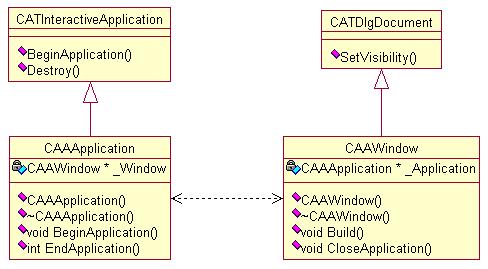
3D PLM Enterprise Architecture |
User Interface - Dialogs |
Designing Your Interactive ApplicationHow to create a separate interactive application |
| Technical Article | ||
AbstractThis article explains you how to create an interactive application, along with the methods you should overwrite from the interactive application base class |
A CAA V5 interactive application is a program that you can launch and that can execute generally with end user input until the end-user stops it. The base class for CAA V5 interactive applications is the the CATInteractiveApplication class. The Dialog framework gives you some key components to design you interactive application. They include:
The figure below shows the objects involved and their main methods using the Unified Modeling Language (UML).

The application derives from the CATInteractiveApplication class while the
window derives from the CATDlgDocument class. The application aggregates a
pointer to the window and instantiates it in the BeginApplication
method. Symmetrically, the window aggregates a pointer to the application.
![]() Note that the window constructor does not include any statement. It only
instantiates, that is allocates memory areas for the window and its base
classes. The
Note that the window constructor does not include any statement. It only
instantiates, that is allocates memory areas for the window and its base
classes. The Build method is dedicated to create the objects with
the proper values. This is because the external resources to allocate use
virtual methods, and as long as the constructor is not exited, the virtual
method table update may not be completed and thus its contents may be
inaccurate. This Build method does not exist in any Dialog
framework base class and thus can not be redefined. You must create it when
deriving a Dialog framework class.
[Top]
The following sample is a standard application skeleton with a main window. It includes the main objects shown in the figure and their related methods. You retrieve the two classes, CAADlgInterApplication and CAADlgInterWindow in the CAADialog.edu framework in the CAADlgInterApplication.m module.
First look at the CAADlgInterApplication header file:
#include "CATInteractiveApplication.h"
class CAADlgInterApplication : public CATInteractiveApplication
{
public:
CAADlgInterApplication (const CATString & iAppliName);
virtual void BeginApplication();
virtual int EndApplication();
virtual ~MyApplication();
};
|
and at the CAADlgInterWindow header file:
#include "CATDlgDocument.h"
class CATInteractiveApplication;
class CAADlgInterWindow: public CATDlgDocument
{
public:
CAADlgInterWindow(CATInteractiveApplication * pp);
virtual ~CAADlgInterWindow();
void Build();
private:
void CloseAppli(CATCommand * iSendingCommand,
CATNotification * iSentNotification,
CATCommandClientData UsefulData);
...
private:
CATInteractiveApplication * _pApplication;
};
|
These class declarations follow the diagram. A pointer to the application is
stored as a document data member. The document includes a Build method to
valuate its objects rather than doing this in the constructor. The method CloseAppli
is used to close both the application and the document when the user requests
it.
The CAADlgInterApplication source file:
CAADlgInterApplication ::CAADlgInterApplication (const CATString & IAppliName)
:CATInteractiveApplication(NULL, IAppliName)
{ }
void CAADlgInterApplication ::BeginApplication()
{
MyDoc = new CAADlgInterWindow(this);
MyDoc->Build();
SetVisibility(CATDlgShow); // make window visible
}
int CAADlgInterApplication ::EndApplication() // called by Destroy
{ return 0; }
CAADlgInterApplication ::~MyApplication() { }
CAADlgInterApplication ApplicationInstance ("MyNiceApplication"); // instantiate the application
|
The CAADlgWindowApplication source file is the following:
...
CAADlgInterWindow ::CAADlgInterWindow (CATInteractiveApplication * iParentCommand)
:CATDlgDocument(iParentCommand, "CAADlgInterWindowId"),
_pApplication(iParentCommand)
{
// Empty constructor to allocate, but not to valuate
}
void CAADlgInterWindow ::Build() {
... // Put here the code required to build the window
// set a callback to close the application when closing the window
AddAnalyseNotificationCB(this,
GetWindCloseNotification(),
(CATCommandMethod)&MyDocument::CloseAppli,
NULL);
}
CAADlgInterWindow ::~CAADlgInterWindow () { }
void CAADlgInterWindow ::CloseAppli // close the application
(CATCommand * _ICommand,
CATNotification * _INotification,
CATCommandClientData UsefulData)
{ _pApplication->Destroy();
_pApplication = NULL ;
}
|
[Top]
The interactive application is simply instantiated without the need of creating any main program. The main dialog window derives from the appropriate dialog window class, and includes a Build method to create the containers and controls that make up the window, rather than using the window constructor to do this. The application and the window aggregates the other by reference.
[Top]
| Version: 1 [Jan 2000] | Document created |
| [Top] | |
Copyright © 2000, Dassault Systèmes. All rights reserved.